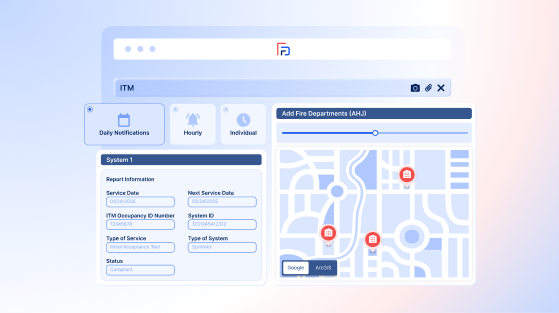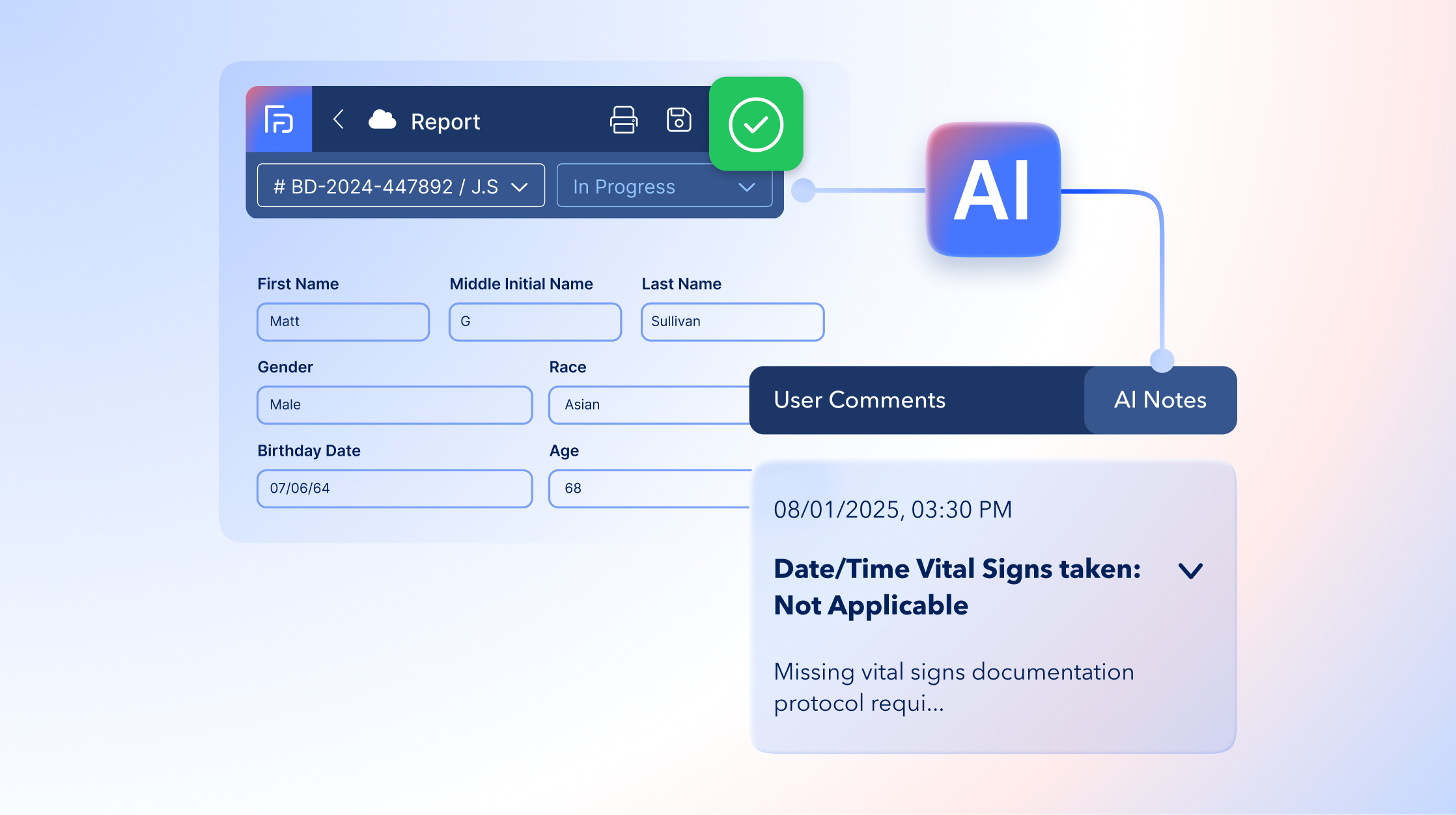Building Stronger Occupancy Records through Inspect, Test, and Maintain (ITM) Programs

Fire prevention begins long before an emergency call. It starts with ensuring that every sprinkler, alarm, and fire protection system in the community is functioning as designed. Inspect, Test, and Maintain (ITM) programs make that possible by verifying that these systems are routinely serviced, tested, and documented.
However, many agencies still manage ITM programs using fragmented tools and disconnected processes. Service providers often send reports through third-party portals, email attachments, or paper mail, leaving AHJs to manually organize and track each submission. These reports may sit in inboxes or file cabinets for days or weeks before review, and by the time deficiencies are discovered, critical systems may have been out of service for months.
This lack of integration slows down enforcement and creates dangerous blind spots. Without a connected workflow, prevention staff cannot easily see which buildings are compliant, which systems have open deficiencies, or where follow-up inspections are needed. The result is a prevention process that is reactive rather than proactive, leaving both first responders and the public at risk.
Why the Traditional Approach Falls Short
Traditional ITM processes rely heavily on manual communication and human follow-up. Reports are emailed, reviewed, and filed by hand, while deficiencies must be tracked separately. This piecemeal approach creates opportunities for missed deadlines, lost reports, and delayed enforcement.
Third-party portals also present challenges when they are not directly connected to the department’s inspection or permitting systems. Even when reports are submitted digitally, they often remain disconnected from occupancy data. This makes it difficult to build a complete picture of each building’s fire protection history and overall compliance.
For busy prevention teams, this creates constant administrative pressure. Staff must search for missing reports, double-check data across platforms, and manually generate inspections. The time spent managing spreadsheets and emails could instead be spent performing inspections or community outreach.
Ultimately, an ITM process built on manual effort cannot keep pace with the growing demands of modern fire prevention.
What a Modern ITM Program Should Look Like
A modern ITM program should be fully connected, transparent, and easy to manage. It should allow service providers to submit inspection, testing, and maintenance reports directly to the AHJ in a standardized format. Those reports should automatically connect to the correct occupancy record, triggering immediate notifications if deficiencies are found.
With an integrated system, the department has full visibility into every fire protection system across its jurisdiction. Building owners and service providers can view the status of their submissions and see exactly what is required for compliance. Inspectors can track upcoming tests, overdue reports, and open deficiencies from one dashboard.
This kind of program replaces guesswork with clarity. AHJs no longer have to search for information or wonder whether a building is compliant. Every report, inspection, and maintenance action becomes part of a continuous, closed-loop process that drives accountability and safety.
%20copy.png)
How Software Simplifies ITM
Technology allows agencies to move from scattered reporting to a unified, data-driven process. With the right software, ITM workflows can be automated from the moment a service provider submits a report. If a deficiency is identified, the system immediately notifies the AHJ, updates the occupancy record, and creates a task for re-inspection or follow-up.
Automated reminders ensure nothing falls through the cracks. Reports that are due for renewal, systems that require retesting, or deficiencies awaiting correction are all tracked automatically. Prevention teams can focus on oversight and enforcement rather than manual coordination.
Analytics and reporting tools also give leaders new visibility into community-wide trends. Dashboards show compliance rates, the number of systems out of service, and recurring deficiencies. This insight allows agencies to target high-risk properties, identify training needs, and allocate inspection resources effectively.
By transforming ITM into a connected digital process, agencies save time, reduce liability, and improve the reliability of their occupancy data.
The Bigger Picture: Connecting ITM to Occupancy Records
When ITM data is linked directly to occupancy records, the benefits extend far beyond compliance tracking. Each inspection, repair, or test becomes part of the building’s complete safety history. Over time, this creates a living record of every fire protection system within the jurisdiction.
This connection allows agencies to understand how systems perform over time, which properties have recurring issues, and where risk is increasing. It also ensures that responders have access to accurate system status information before they arrive on scene. Knowing whether a sprinkler or alarm system is operational helps responders make safer and faster decisions during an incident.
By viewing ITM as part of a larger prevention and response ecosystem, departments can build stronger data, improve coordination, and ultimately protect both lives and property more effectively.
Why First Due
First Due’s Inspect, Test, and Maintain solution brings the entire fire protection process under one roof. Service providers can easily submit reports through a secure portal that automatically routes to the correct AHJ. Each submission connects directly to the corresponding occupancy record, ensuring that every test, inspection, and deficiency is captured accurately.
When deficiencies are found, First Due automatically generates inspection tasks, sends notifications, and flags the occupancy for follow-up. AHJs can view all open issues in one dashboard, complete with real-time status updates. Responders can also access system information through their pre-plan view, giving them the awareness they need before arriving on scene.
The platform not only streamlines workflows but also strengthens community safety. By eliminating fragmented systems and paper-based tracking, First Due helps agencies achieve true visibility across their entire prevention landscape. The result is fewer missed deficiencies, faster compliance resolution, and a complete record that connects prevention and response in one place.
First Due was designed to help fire departments operate proactively rather than reactively. With ITM fully integrated into occupancy records, agencies gain the confidence that every building is accurately documented and every system is maintained to code.
Fire prevention begins long before an emergency call. It starts with ensuring that every sprinkler, alarm, and fire protection system in the community is functioning as designed. Inspect, Test, and Maintain (ITM) programs make that possible by verifying that these systems are routinely serviced, tested, and documented.
However, many agencies still manage ITM programs using fragmented tools and disconnected processes. Service providers often send reports through third-party portals, email attachments, or paper mail, leaving AHJs to manually organize and track each submission. These reports may sit in inboxes or file cabinets for days or weeks before review, and by the time deficiencies are discovered, critical systems may have been out of service for months.
This lack of integration slows down enforcement and creates dangerous blind spots. Without a connected workflow, prevention staff cannot easily see which buildings are compliant, which systems have open deficiencies, or where follow-up inspections are needed. The result is a prevention process that is reactive rather than proactive, leaving both first responders and the public at risk.
Why the Traditional Approach Falls Short
Traditional ITM processes rely heavily on manual communication and human follow-up. Reports are emailed, reviewed, and filed by hand, while deficiencies must be tracked separately. This piecemeal approach creates opportunities for missed deadlines, lost reports, and delayed enforcement.
Third-party portals also present challenges when they are not directly connected to the department’s inspection or permitting systems. Even when reports are submitted digitally, they often remain disconnected from occupancy data. This makes it difficult to build a complete picture of each building’s fire protection history and overall compliance.
For busy prevention teams, this creates constant administrative pressure. Staff must search for missing reports, double-check data across platforms, and manually generate inspections. The time spent managing spreadsheets and emails could instead be spent performing inspections or community outreach.
Ultimately, an ITM process built on manual effort cannot keep pace with the growing demands of modern fire prevention.
What a Modern ITM Program Should Look Like
A modern ITM program should be fully connected, transparent, and easy to manage. It should allow service providers to submit inspection, testing, and maintenance reports directly to the AHJ in a standardized format. Those reports should automatically connect to the correct occupancy record, triggering immediate notifications if deficiencies are found.
With an integrated system, the department has full visibility into every fire protection system across its jurisdiction. Building owners and service providers can view the status of their submissions and see exactly what is required for compliance. Inspectors can track upcoming tests, overdue reports, and open deficiencies from one dashboard.
This kind of program replaces guesswork with clarity. AHJs no longer have to search for information or wonder whether a building is compliant. Every report, inspection, and maintenance action becomes part of a continuous, closed-loop process that drives accountability and safety.
%20copy.png)
How Software Simplifies ITM
Technology allows agencies to move from scattered reporting to a unified, data-driven process. With the right software, ITM workflows can be automated from the moment a service provider submits a report. If a deficiency is identified, the system immediately notifies the AHJ, updates the occupancy record, and creates a task for re-inspection or follow-up.
Automated reminders ensure nothing falls through the cracks. Reports that are due for renewal, systems that require retesting, or deficiencies awaiting correction are all tracked automatically. Prevention teams can focus on oversight and enforcement rather than manual coordination.
Analytics and reporting tools also give leaders new visibility into community-wide trends. Dashboards show compliance rates, the number of systems out of service, and recurring deficiencies. This insight allows agencies to target high-risk properties, identify training needs, and allocate inspection resources effectively.
By transforming ITM into a connected digital process, agencies save time, reduce liability, and improve the reliability of their occupancy data.
The Bigger Picture: Connecting ITM to Occupancy Records
When ITM data is linked directly to occupancy records, the benefits extend far beyond compliance tracking. Each inspection, repair, or test becomes part of the building’s complete safety history. Over time, this creates a living record of every fire protection system within the jurisdiction.
This connection allows agencies to understand how systems perform over time, which properties have recurring issues, and where risk is increasing. It also ensures that responders have access to accurate system status information before they arrive on scene. Knowing whether a sprinkler or alarm system is operational helps responders make safer and faster decisions during an incident.
By viewing ITM as part of a larger prevention and response ecosystem, departments can build stronger data, improve coordination, and ultimately protect both lives and property more effectively.
Why First Due
First Due’s Inspect, Test, and Maintain solution brings the entire fire protection process under one roof. Service providers can easily submit reports through a secure portal that automatically routes to the correct AHJ. Each submission connects directly to the corresponding occupancy record, ensuring that every test, inspection, and deficiency is captured accurately.
When deficiencies are found, First Due automatically generates inspection tasks, sends notifications, and flags the occupancy for follow-up. AHJs can view all open issues in one dashboard, complete with real-time status updates. Responders can also access system information through their pre-plan view, giving them the awareness they need before arriving on scene.
The platform not only streamlines workflows but also strengthens community safety. By eliminating fragmented systems and paper-based tracking, First Due helps agencies achieve true visibility across their entire prevention landscape. The result is fewer missed deficiencies, faster compliance resolution, and a complete record that connects prevention and response in one place.
First Due was designed to help fire departments operate proactively rather than reactively. With ITM fully integrated into occupancy records, agencies gain the confidence that every building is accurately documented and every system is maintained to code.
.png)






